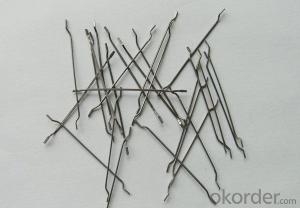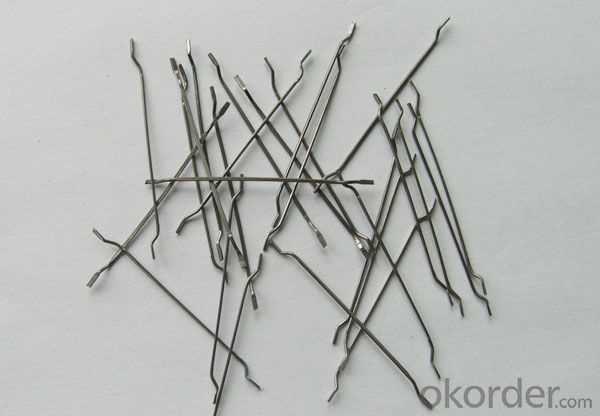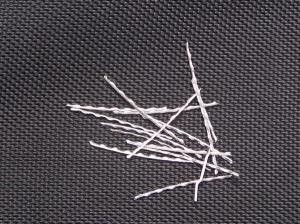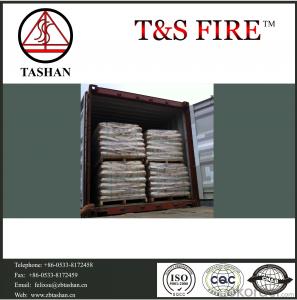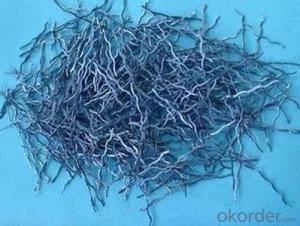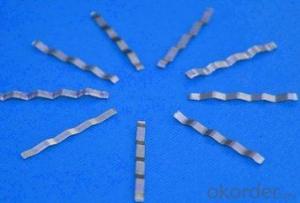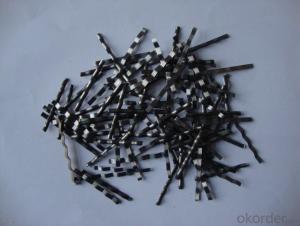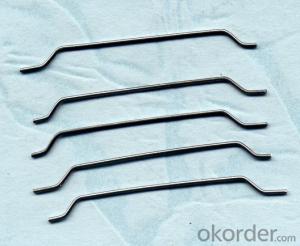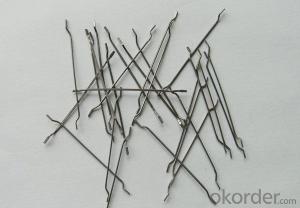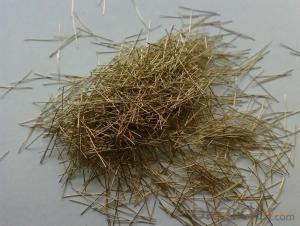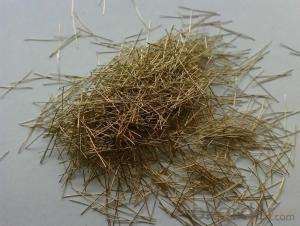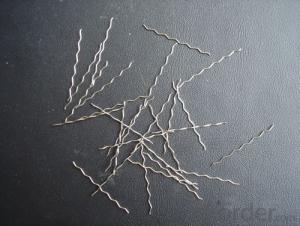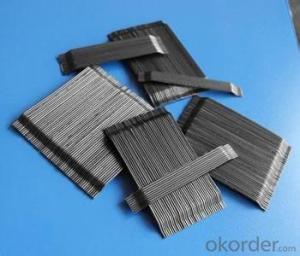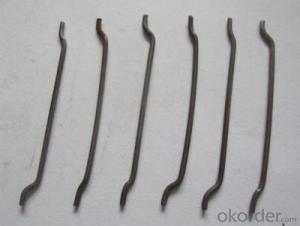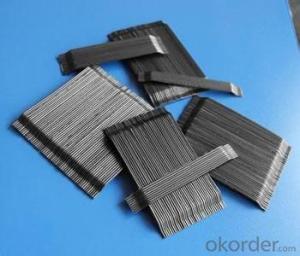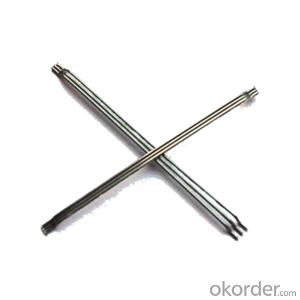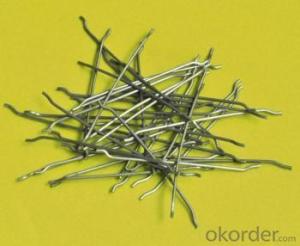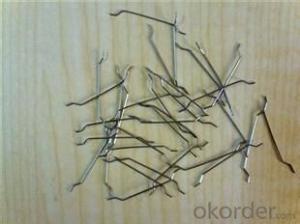Melt Extract Stainless Steel Fiber with Copper Coated Hooked Ends Steel Fiber from China
- Loading Port:
- Tianjin
- Payment Terms:
- TT OR LC
- Min Order Qty:
- 1000 kg
- Supply Capability:
- 30000 kg/month
OKorder Service Pledge
OKorder Financial Service
You Might Also Like
Quick Details
Place of Origin: Jiangsu, China (Mainland)
Model Number: HT-ST
Material: Steel
Specifications
(1) greatly improve concrete bonding and tensile strength
(2) improve mechanical performance concrete
(3) prevent the damage to the concrete
(4) decrease the danger from crack of the concrete
(5) provide exceptional load stability and durability
Uses
Steel fiber concrete has already been used for and wide on to many fields,such as road,bridge ,airport runway,tunnel ,culvert,hydro-power project,inner lining of underground construction.Port and pier,ocean project,nuclear test base rocket launch site,anti-earthquake building,ect
Picture
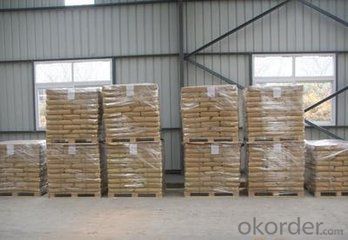
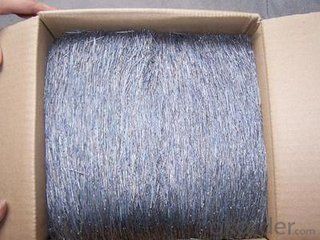
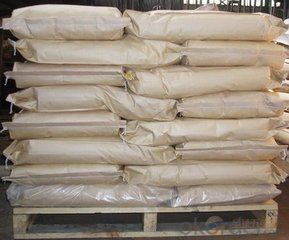
Steel fiber
FAQ
1. Directadding steel fibers to the belt,the rows of steel fiber as a whole,each of the concrete uniformly dispersed Corner
2. A water-soluble glue starts to dissolve,in a row of steel fibers in a dispersion premise,dispersed again in every corner of the monofilament fiber,showing a perspective view in the concrete of the fiber web, which play the role of an overall reinforcement.
3. Compare to the monofilament fiber,the glued steel fiber wouldn't be tied up,to ensure that the fibers in the concrete mixing does not agglomerate,distributed evenly.
- Q: Can melt extract stainless steel fiber be used in the construction of bridge decks?
- Yes, melt extract stainless steel fiber can be used in the construction of bridge decks. Stainless steel fiber reinforcement offers several advantages for bridge deck construction. Firstly, stainless steel fibers provide excellent crack control, helping to prevent the formation and propagation of cracks in the concrete. This is crucial for bridge decks, as they are constantly exposed to heavy traffic loads and various environmental factors that can cause cracking. Additionally, stainless steel fibers improve the durability and longevity of the bridge deck by enhancing its resistance to corrosion and abrasion. Stainless steel is inherently resistant to rust and can withstand harsh weather conditions and exposure to chemicals, making it an ideal material for bridge deck construction. Moreover, melt extract stainless steel fibers enhance the flexural strength and toughness of the bridge deck. This is particularly important for bridge decks, as they need to withstand dynamic loads and provide sufficient structural integrity. In summary, melt extract stainless steel fibers can be effectively used in the construction of bridge decks due to their crack control properties, durability, corrosion resistance, and enhancement of flexural strength and toughness.
- Q: Can melt extract stainless steel fiber be used in swimming pools or water treatment plants?
- Yes, melt extract stainless steel fiber can be used in swimming pools and water treatment plants. It is highly resistant to corrosion and can withstand the harsh conditions associated with water treatment facilities. Additionally, the stainless steel fiber enhances the strength and durability of the concrete used in these structures, making it an ideal choice for such applications.
- Q: What is the effect of melt extract stainless steel fiber on the crack width of concrete elements?
- The utilization of melt extract stainless steel fiber in concrete elements yields a positive impact on the reduction of crack width. When introduced into the concrete, these fibers aid in bolstering its tensile strength and obstructing the spread of cracks. Acting as reinforcement, the fibers evenly distribute stress and forces throughout the concrete, thereby diminishing the probability and severity of cracks. Through the inclusion of stainless steel fibers, the concrete acquires heightened resistance to cracking, particularly in the face of shrinkage, temperature fluctuations, and external loads. The fibers adeptly bridge any fissures that may arise, confining their width and preventing further expansion. Furthermore, melt extract stainless steel fibers exhibit superior resistance to corrosion when compared to alternative fiber types, ensuring the long-term endurance and structural soundness of the concrete elements. This augmented resistance to corrosion serves to further reduce crack width, as cracks induced by corrosion can result in substantial structural harm. In conclusion, the integration of melt extract stainless steel fiber in concrete elements yields a favorable outcome on crack width. It aids in minimizing the formation of cracks and constrains their growth, thereby fostering improved performance, extended service life, and heightened structural integrity of the concrete elements.
- Q: Does melt extract stainless steel fiber enhance the impact resistance of concrete slabs?
- Yes, melt extract stainless steel fiber does enhance the impact resistance of concrete slabs.
- Q: How does melt extract stainless steel fiber improve the fire resistance of shotcrete?
- Melt extract stainless steel fiber improves the fire resistance of shotcrete by providing enhanced structural integrity and heat resistance. The fibers act as reinforcement, reducing cracking and spalling during high temperatures. This helps to maintain the structural stability of the shotcrete, preventing it from collapsing or disintegrating under fire conditions. Additionally, the stainless steel fibers create a barrier that slows down heat transfer, reducing the spread of fire within the shotcrete. Overall, the inclusion of melt extract stainless steel fiber significantly enhances the fire resistance of shotcrete, making it a more reliable and durable material for fire protection applications.
- Q: What is the lifespan of concrete reinforced with melt extract stainless steel fiber?
- The lifespan of concrete reinforced with melt extract stainless steel fiber can vary depending on various factors such as the quality of the concrete mix, the environmental conditions it is exposed to, and the maintenance practices followed. However, on average, this type of reinforcement can significantly extend the lifespan of concrete compared to traditional reinforcement methods. It can enhance durability, increase resistance to cracking and corrosion, and improve structural integrity, potentially leading to a longer service life for the concrete.
- Q: How does melt extract stainless steel fiber enhance the resistance of concrete to dynamic loading?
- Melt extract stainless steel fiber enhances the resistance of concrete to dynamic loading by improving its tensile strength and ductility. The fibers act as reinforcements within the concrete matrix, distributing the load more evenly and reducing the formation and propagation of cracks. This results in a more durable and resilient concrete structure that can withstand the impact and vibrations caused by dynamic loading, such as heavy traffic, seismic activity, or machinery operations.
- Q: How does melt extract stainless steel fiber enhance the fatigue resistance of concrete?
- Concrete's fatigue resistance can be enhanced by adding melt extract stainless steel fiber. This reinforcement improves the structural integrity of the concrete and provides additional strength. The fibers create a three-dimensional network that helps distribute stress and load, acting as a barrier to crack propagation and preventing the formation and growth of micro-cracks that can lead to fatigue failure. The high tensile strength and ductility of stainless steel fibers allow them to effectively absorb and disperse energy during cyclic loading, reducing stress concentration at potential crack initiation points. This significantly improves the fatigue life of the concrete by preventing crack development and extending the overall durability and lifespan of the structure. In addition, the corrosion resistance of stainless steel fibers is crucial for enhancing concrete's fatigue resistance. Unlike other fibers, stainless steel fibers are not affected by corrosion from moisture, chemicals, or environmental factors. This ensures that the fibers remain effective and intact over time, even in harsh conditions, further enhancing the concrete's fatigue resistance. Overall, the inclusion of melt extract stainless steel fibers in concrete enhances its fatigue resistance by providing additional reinforcement, reducing crack propagation, absorbing and dispersing energy, and improving its durability and corrosion resistance. This results in a more resilient and long-lasting concrete structure, especially in applications subjected to cyclic loading and fatigue stress.
- Q: What is the effect of melt extract stainless steel fiber on the modulus of brittleness of concrete?
- The effect of melt extract stainless steel fiber on the modulus of brittleness of concrete is that it increases the ductility and flexural strength of concrete, thereby reducing its brittleness. The addition of stainless steel fibers improves the crack resistance and enhances the overall performance of concrete by preventing the propagation of cracks and increasing its ability to withstand external forces and impacts.
- Q: How does melt extract stainless steel fiber impact the load transfer between concrete layers?
- Melt extract stainless steel fibers enhance load transfer between concrete layers by improving the bond strength and overall mechanical properties of the concrete. These fibers act as reinforcement, dispersing stress and preventing crack propagation, thereby increasing the load-carrying capacity and durability of the concrete structure.
Send your message to us
Melt Extract Stainless Steel Fiber with Copper Coated Hooked Ends Steel Fiber from China
- Loading Port:
- Tianjin
- Payment Terms:
- TT OR LC
- Min Order Qty:
- 1000 kg
- Supply Capability:
- 30000 kg/month
OKorder Service Pledge
OKorder Financial Service
Similar products
Hot products
Hot Searches
Related keywords
